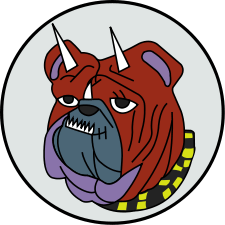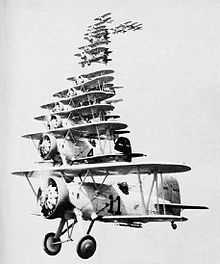VMF-111
| Marine Fighting Squadron 111 | |
|---|---|
 VMF-111 Insignia | |
| Active |
September 1, 1925 - November 26, 1945 June 1, 1948 - October 22, 1965 |
| Country |
|
| Branch |
|
| Type | Fighter squadron |
| Role | Air interdiction |
| Part of | Inactive |
| Nickname |
"Rojo Diablos" (1930s)[1] "Devil Dogs" (WWII) |
| Tail Code | 5D |
| Engagements |
World War II * Solomon Islands Campaign |
| Commanders | |
| Notable commanders | Christian F. Schilt |
| Aircraft flown | |
| Fighter |
Vought VE-7 Boeing FB-1 Curtiss F6C-4 Curtiss F7C-1 Boeing F4B-4 Grumman F3F-2 F4F Wildcat F4U Corsair AF-1E Fury’s F-8 Crusader |
Marine Fighting Squadron 111 (VMF-111) was a reserve fighter squadron in the United States Marine Corps. Nicknamed the “Devil Dogs”, the squadron was one of the first aviation squadrons in the Marine Corps and gained national attention in the 1930s as the Marine Corps show unit. The squadron fought in World War II and was later transferred to the Reserves where they fell under the command of Marine Aircraft Group 41 (MAG-41) and the 4th Marine Aircraft Wing (4th MAW) while stationed at Naval Air Station Dallas, Texas. They were decommissioned on the October 22, 1965.
History
Early years
Marine Fighting Squadron 2 (VF-2M) was activated on September 1, 1925 at Marine Corps Base Quantico, Virginia. The directive authorizing the formation of the squadron stated, "The primary mission of this squadron will be the training and perfecting of pursuit pilots and the testing and development of pursuit aircraft."[2] They were redesignated VF-9M on July 1, 1927 which was changed again to VF-5M on July 1, 1928.[3]

Because they were located so close to Washington D.C., the squadron became the "show unit" for Marine aviation. The squadron reverted to the previous designation of VF-9M on August 1, 1930.[3] In 1937, after a stint aboard the USS Saratoga (CV-3) under the command of then Captain Bull Halsey, VF-9M was again redesignated, becoming VMF-1.[3] The squadron finally became VMF-111 on July 1, 1941 during the massive expansion of the Marine Corps that began just prior to World War II.[3]
World War II
At the time of the Attack on Pearl Harbor, VMF-111 pilots were flying the F4F Wildcat. On March 10, 1942, the squadron arrived at Tafuna Airfield on Tutuila island, its new base of operations. They were the first Marine squadron to operate in Samoa.[4] and eventually were relocated to Faleolo Airfield on Upolu Island after SeeBees completed Feleolo Airfield in July 1942. They spent the next year as part of the Samoa Defense Garrison Area and finally transitioned to the F4U Corsair in early 1943. The squadron remained in Samoa until 1944, serving as a replacement pool for other squadrons engaged in the Solomon Islands Campaign.
VMF-111 left Samoa in January 1944 for the Central Pacific and participated in raids against bypassed Japanese garrisons for the rest of the war. It was during this time that the squadron, under the command of Major William E. Classen, made the first experimental bombing run with F4U Corsairs when eight of their aircraft struck heavy anti-aircraft positions on Mili Atoll with thousand pound bombs[5] Following the war the squadron returned to the States where it was deactivated on November 26, 1945.

Post war years
Reactivated on June 1, 1948 as part of the Marine Air Reserve, VMF-111 was stationed at Naval Air Station Dallas. They were recalled to active duty on July 23, 1950 due to the Korean War but did not see any action. Instead they assumed their World War II role of training pilots. They were released from active duty in July 1953 and remained at NAS Dallas until their deactivation on October 22, 1965.[6] Upon deactivation, their personnel and aircraft were turned over to VMF-112.[7]
Squadron Aces
- George L. Hallowell
See also
- United States Marine Corps Aviation
- List of active United States Marine Corps aircraft squadrons
- List of inactive United States Marine Corps aircraft squadrons
References
Notes
- ↑ Barrow 1981, p. 41.
- ↑ Barrow 1981, p. 10.
- ↑ 3.0 3.1 3.2 3.3 Barrow 1981, p. 235.
- ↑ Sherrod 1952, p. 218.
- ↑ Dechant (1947): During this combat deployment, VMF-111 was the first squadron to use the centerline-mounted Brewster bomb rack on the F4U Corsair, proving the Corsair as a true fighter-bomber. Also, VMF-111 has the distinction of operating "Old #122," the only known U.S. aircraft of the war to fly one hundred combat missions with no mechanical problems. The aircraft received a Presidential citation for its unique service record. 154
- ↑ The History o MAG-41. Marine Aircraft Group 41. 2005. Archived from the original on 2007-03-30. Retrieved 2007-03-01.
- ↑ "Marine Gunfighters". The Gunfighter's Page. Retrieved 2007-03-01.
Bibliography
- Barrow, Jess C. (1981). WW II:Marine Fighting Squadron Nine (VF-9M). Blue Ridge Summit, PA: TAB Books Inc. p. 239. ISBN 0-8306-2289-6.
- Crowder, Michael J. (2000). United States Marine Corps Aviation Squadron Lineage, Insignia & History - Volume One - The Fighter Squadrons. Paducah, KY: Turner Publishing Company. ISBN 1-56311-926-9.
- De Chant, John A. (1947). Devilbirds. New York: Harper & Brothers Publishers.
- Rottman, Gordon L. U.S. Marine Corps World War II Order of Battle: Ground and Air Units in the Pacific War, 1939-1945. Greenwood Press, 2002. ISBN 0-313-31906-5.
- Sherrod, Robert. History of Marine Corps Aviation in World War II. Washington, D.C.: Combat Forces Press, 1952. ISBN 0-933852-58-4.
- Tillman, Barrett. Corsair: The F4U in World War II and Korea. Annapolis, MD: Naval Institute Press, 1979. ISBN 1-55750-994-8.
- Web
| ||||||||||||||||||||||||||
